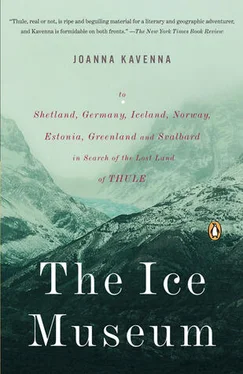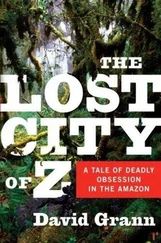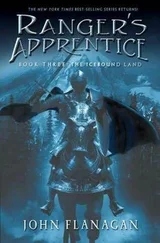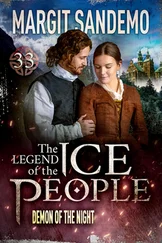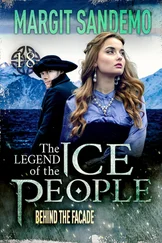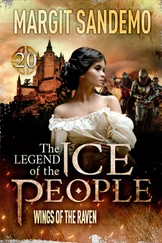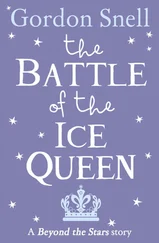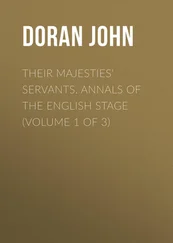We passed slowly through a stretching shambles of islets and inlets, with the sun spreading across the sky. The light was gleaming across the pastel mountains, turning them purple. The sun shone like fire on the rock pillars. Small villages emerged out of the rock desert, and receded again, as the boat moved onwards into further miles of slab rocks lurking above the sea. There was the constant background hum of the engines and the gentle slap of water swirling around the bows. I sat on the deck watching the deckhands coil the ropes, and then I dozed for a few hours, curled in a sleeping bag, under the shelter of the ship’s bridge.
After Thule, as Nansen defined it, the stark crags of the Lofoten Islands emerged ahead—an archipelago of barren crinkled rocks, emerging violently from the sea. Lashed by storms in winter, serene and mist-scaped in summer. An immense wall of rocks loomed ahead, a line of mountains in the ocean. Rocks in the gathering dusk, looking like a vast island. Before the sun set, the boat made a detour into Trollfjord—the gathering shadows playing across the blackened crags, snow glinting like mist in patches on the rocks. I was woken by the shuddering of the boat as it turned around at the end of the fjord. The enormous sheer sides had been crushed close together, leaving a gap barely wide enough for the ship between them. In the half-light, it seemed to me that the rock formations of Trollfjord resembled nothing so much as anguished faces, encased in stone: great simian ridges, deep sockets, gaping mouths, severe and strange.
In his Arctic history In Northern Mists , Nansen had written about a mythical ancient tribe of the far north, the Hyperboreans. The Hyperboreans were a people who knew neither war nor injustice, neither age nor disease; they supped with divinities, they invited Apollo over for a dance and dinner, they entertained heroes, Perseus among them. Only the divine and semi-divine knew where the Hyperboreans lived; the poet Pindar gave elusive descriptions: ‘travelling neither by ships nor on foot could you find/ the way to the assembly of the Hyperboreans.’ They were an immortal race, living beyond the fierce north wind, in farthest northern Ocean, where the tired stars sank to rest, where the moon was so near that it was possible to see the imperfections on its surface. Some sources said there was a marvellous temple, shaped like a sphere, which floated freely in the air, borne by the winds. There were three giant brothers there, twelve feet high, who performed the service of priests to the sanctuary. When they offered the sacrifice and sang hymns to the sound of the cithara, whole clouds of swans surrounded the temple and settled upon it.
Though they lived in the northern zone, their land seemed to be quiet and perfect, a place free of the harshness of the north wind, of the sleet and snow, the driving rain. They were the only race living in the north-east who did not encroach continually on their neighbours, unlike the Scythians, Issedones and Arimaspians, who were cramped together in the north, and oppressed constantly by griffins and other bizarre creatures. The Hyperboreans were a musical tribe, passing the days playing the lyre and the pipes, listening to choirs. They had escaped Nemesis, and when they grew tired of life—of this song-filled, flower-strewn life—they threw themselves, with wreaths in their hair, from a cliff into the sea.
The myth of the Hyperboreans was gradually entwined with Thule, so the poets sometimes wrote about the Hyperborean waves crashing on the shores of Thule, or the Hyperborean peoples of Thule. They seemed the right sort of inhabitants for a mystery isle; their origins as uncertain as those of the land of Thule, any lurking truth clouded by anecdote and poetry. Nansen was a scholar of precision; he dismissed suggestions that the Hyperboreans might actually have been an early Germanic tribe. But when Nansen named Norway as Thule he knew the Hyperboreans were part of the mythical package. It flattered the people, the notion that their nation might have been visited by Pytheas, that it might have been the source of the idea of Thule. And it also flattered the people to link them imaginatively with the Hyperboreans, the grand old immortals of the north. It was a useful piece of national symbolism, for a nation finding its feet, struggling to emerge from centuries under the overall control of its neighbours, Denmark and Sweden. Nansen had a strong sense of ancestral pride; the Viking exploration of the far north received extensive coverage in In Northern Mists . His Thule bound the Norwegians up with the discovery of the far north, making them an ancient nation of Arctic people: first the local population welcoming the explorer Pytheas, and later the explorers themselves, pushing towards the North and South Poles.
Nansen’s patriotism was of a robust sort; he had been a key negotiator during the Norwegian independence talks with Sweden, a key representative of Norway abroad, a key candidate for president. Yet Nansen was never blindly partisan; he was never obsessed with his own country, to the exclusion of all others. He ceded the Arctic quest to Amundsen, a relentless, obsessively driven explorer, who cared less about international geopolitics and more about simple adventure. Nansen turned to the epic disaster of Russia in the post-Revolution era. During the 1920s, he became involved with the League of Nations, working as high commissioner for the repatriation of prisoners of war, helping to return Russian prisoners held in Germany and German prisoners held in Russia. He worked to alleviate the famine that hit Russia in 1921; when he was awarded the Nobel Peace Prize in 1922 he used the money to establish farms in the Volga region and the Ukraine. The Nobel Prize particularly recognized his part in devising the Nansen passport, which supplied stateless refugees with identity and travel papers; beneficiaries included Vladimir Nabokov’s family. He was accused of naivety, by his peers and by later writers, of being manipulated equally by the Americans and the Russians. He might have been aware of the tactics around him, but was too fixed on his goal to care.
And in the 1920s, as Norse mythology was bound into nationalism in the northern countries, Nansen was linked to a folksy domestic party called the Fatherland League. The Fatherland League wanted a strong Norway, a nation that could protect itself from the creeping threat of Communism, as they saw it. Nansen lent his powerful jowls, his sonorous charisma-drenched presence, to its calls for the Norwegians to fulfil their potential. Even in this, he couldn’t stay with empty phrases, with rhetoric stripped away from action. He was increasingly a reluctant figurehead, too diverse for the shriller forms of nationalism. It was a fortunate reluctance, prescient in the circumstances: after Nansen’s death, the Fatherland League was drawn towards extremism, hijacked by Nazi sympathizers.
The boat passed crags to starboard, with tree-coated rocks low in the fjord, and I thought of Nansen’s house outside Oslo, which I had visited on the way to Bergen. I had arrived on a bus out of Oslo, which had stopped on a major road. Nansen’s house lay up a narrow lane; when he lived there it had stood beyond the limits of the city. Most of the house was being used as a research institute, but the director of the institute took me up to an unheated room, at the top of the house. The room was usually kept locked, and the researchers stayed away, but the director had a key; his office, he told me, was just opposite, and a sense of the past must have permeated his days, as he walked past the locked door. He twisted the key and we entered a neat study, with a view of rust-coloured ivy clambering on the walls outside. On the desk there were hundreds of handwritten sheets of paper in neat piles. There were shelves stacked with leather-bound books, and cloying pre-Raphaelite paintings on the walls. More austere were the black-and-white photographs, scattered around, of an explorer, diplomat, statesman and his family. As I stood by the desk, my hand on the chair Nansen had sat in, I felt the sense of a gap. The trappings remained, preserved in their places, but the unifying consciousness had vanished. A few Nansen flasks were stacked in a corner, for taking samples from the ocean, just one of Nansen’s inventions, which had included the tailored runners of his Nansen sledge, and his own recipe for pemmican. There were files of correspondence from Russians, stacks of fountain pens, knives to sharpen pencils. Nansen had laboured in the room, struggling to solve the problems of another nation, writing letters, preparing his notes, petitioning governments and the League of Nations. Nansen had overworked in the small cluttered study throughout the 1920s. He saw the carnage of the First World War, and he kept thinking that hard work might solve it. Yet he couldn’t gather all the parts together.
Читать дальше
